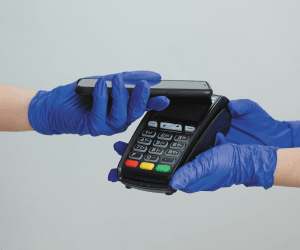
Mobile Payment Options in Demand
February 22, 2022
4 minute ReadBY SHERYL S. JACKSON
“U Can’t Touch This” has become more than a catchy MC Hammer title over the past year, especially when it comes to payment options, such as contactless or contact-free payment. It has become a way of life as people and businesses are doing all they can to help prevent the spread of COVID-19. The COVID-19 pandemic has affected everyone’s daily lives globally and changed the way interactions with businesses are perceived and handled.
This mindset has led to greater interest in contact-free payment and purchase of washes, said Matt McCulloch, Chief Executive Officer of Mosaic. “In 2019, we would not even have a client or potential client discuss contact-free options, but now car wash owners are concerned about protecting the health and safety of their employees as well as customers,” he said. “Owners also realize that customers now choose which businesses they want to use by evaluating how safe they feel at the business.”
Results of the 2019 U.S. Car Wash Consumer Study conducted by the International Carwash Association in August 2019, demonstrated consumers’ preference to order and pay for a wash through a touch screen or pay station (32%) versus paying an employee at a pay station (26%). Survey results also showed that 66% of respondents indicated a desire for a smartphone app that would support payment for the car wash with a linked credit card.
Based on the results of this study, consumers were leaning toward contactless payment options and near field communications (NFC) for tap-and-pay smartphone applications even before the hands-free practices incorporated during the COVID-19 crisis.
“Today, consumers want to pay differently,” said Todd Davy, Senior Vice President of Sales at DRB Systems.
Ordering and paying online through a web application is another way people have learned to minimize contact during their interactions with businesses. “One reason for growth in this form of payment — even before COVID-19 — is the predominance of credit card or debit card payments versus cash,” Davy said.
Many payment system providers have offered contract-free technology in the form of mobile applications that tie to websites or are managed on the cloud through the application for many years. “These strategies do not require a huge investment but the car wash owner’s website must be mobile-friendly,” Davy said. “The customer can pay through the application and the website generates a bar code to use at the pay station.”
According to Davy, recognizing the importance of mobile access to websites and ensuring that the website can be easily viewed and used to purchase items, manage individual accounts and submit payments is critical for today’s car wash owner.
Technology such as voice recognition at the pay station, license plate recognition, and virtual assistant artificial intelligence (AI) technology in cars are all possible today, but not all new technology can simply be added on to or integrated with every existing payment system, said Mike Jorgensen, Sales Manager for XpresWash. “Many of us who work with payment technology have been monitoring emerging technologies like biometrics that use fingerprints to identify customers and verify payment — a solution that may not be popular after COVID-19 — as well as retinal identification,” he said. “Although we can imagine all of this, the reality of implementing these new technologies in the car wash industry is that some of the older point-of-sale (POS) systems are antiquated and won’t support those new technologies.”
The best option for most car wash owners who want to quickly move to a contact-free, convenient payment system is a mobile application that can be added on to existing systems, said Jorgensen. “A lot of POS manufacturers have contact-free options that can be added onto existing systems,” he said. “Car wash owners should do their homework to be sure the add-on will provide the convenience, safety and reliability that their customers want.”
“Implementing new technology can be overwhelming because it is difficult to fully understand how it works,” said McCulloch. “When evaluating the purchase of new technology for the POS system, be sure that it is easy for customers to use, communicates with other car wash systems, and is PCI compliant to protect customers’ sensitive information.”
Over the past few years, the use of mobile applications or other technology such as license plate recognition has shifted from nice to have to need to have status, said McCulloch. A good way to approach implementation of new technology into a business is to choose a solution that can be implemented in small steps. “Technology that is flexible and allows the operator to implement the new services in phases is less overwhelming and easier to introduce to employees and customers,” he said.
Don’t forget to plan for the future, said McCulloch. “Good technology is agnostic — which means it will work with other technology, which allows the car wash owner to adopt other technology in the future,” he said.
“I’ve been in this business for 23 years, and 10 years ago, the car wash industry would not be in a position to easily adopt new forms of payment,” Davy said. “Now, most owners don’t have to invest in a new POS, they can just improve what they have meet their customers’ new expectations.”








